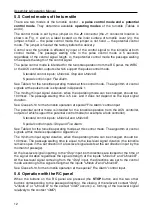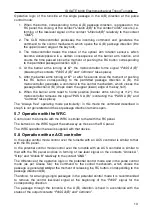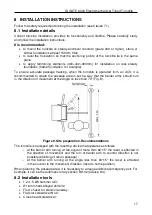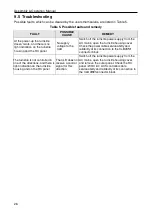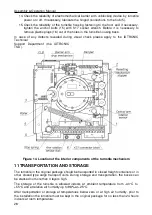
ID GATE 6000 Electromechanical Tripod Turnstile
23
9 OPERATION INSTRUCTIONS
Follow the turnstile operation safety requirements (see Clause 7.2
«Operation safety
requirements»
.
It is prohibited!
•
To move through the turnstile passage area any objects with dimensions
exceeding the width of the passageway.
•
To jerk hit barrier arms, turnstile housing and light indication display so as to
prevent their mechanical deformation.
•
To disassemble and regulate turnstile components.
•
To use abrasive or chemically active substances for cleaning of the turnstile
external surfaces.
9.1 Power-up
Follow these steps: Power-up
1. Connect the AC power cable (8) of the turnstile power supply (9) to the AC outlet
with the voltage and frequency rating according to the certificate for power supply.
2. Switch on the turnstile power supply (9). At the set pulse control mode, the turnstile
switches to
«Always locked»
mode. At the set potential control mode, the turnstile
switches to
«Both directions locked»
mode. At the same time the red LED indication
of the turnstile cover showing the ban on passage and the indicator above the
STOP
button on the RC panel (13) light up.
3. Lift up the barrier arm (3). It will be fixed automatically.
4. Check operation of the intrusion detector and siren (if included in the delivery set
and installed accordingly). After the power-up wait until the moment of the test
indicator (inside the intrusion detector) going off (from 10 to 50 sec). Put your hand
before the intrusion detector. The continuous signal will sound when the intrusion
detector activates. To eliminate that sound signal press any button on the RC panel.
The sound will stop without pressing the button in 5 sec.
The turnstile is ready for operation.
9.2 Operating modes of the turnstile at pulse control mode
After switch on the power supply the turnstile is automatically switched to
«Always locked»
mode.
See Table 3 for the operating modes set from the RC panel and for the corresponding
indication. Setting the operating modes for each direction is independent, i.e. setting the
operating mode for one direction does not change the operating mode set earlier for the
opposite one.
The RC panel overall view is given in Fig. 3.
•
The
“Single
passage in the set
direction”
mode can be changed to the
“Alw
ays
free”
mode for the same direction, or to the
“Always locked”
mode;
•
The
“Free
passage in the set
direction”
mode can be changed to the
“Always
locked”
mode only.
•
In the
“Single
passage in the set
direction”
mode the turnstile will close
automatically after a
person’s
passage in the set direction. The turnstile will also
close automatically, if the passage is not made within 5 sec.
•
In the
“Bi
-directional single pas
sage”
mode after the passage in one direction the
countdown of the passage waiting time (5 sec.) for the opposite direction is
recommenced.




